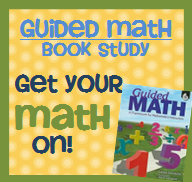Please join in discussing Chapter 4 of Guided Math with Brittany at Sweet Seconds and Katie at Once Upon a Teaching Blog. Thanks for hosting ladies!
“Using Guided Math with the Whole Class”
Advantages of Whole-Class Instruction
- presenting mini lessons
- involving students in activating strategies
- reading aloud mathematics-related literature
- setting the stage for Math Workshop
- conducting a Math Huddle
- providing practice and review
- formal testing or assessments
Mini Lessons
- Connection
- With yesterday’s lesson
- With the ongoing unit of study
- With students’ work
- With an experience outside of school
- Teaching point
- Present verbally
- Demonstrate or model
- Active Engagement
- Students try out a skill or strategy
- Students act like researchers as they watch a demonstration
- Students plan their work out loud
- Students imagine trying a skill or strategy
- Link to Ongoing Student Work
- Students turn to their own work and apply the teaching point
Tips for Effective Mini Lessons
- Limit student talk
- Keep the connection brief
- State the teaching point simply and reiterate it
- Demonstrate the mathematics teaching point
- Use a familiar context for problem solving
- Match the active engagement to the mathematics teaching point
Activating Strategies
- KWL Charts
- Anticipation Guides
- Word Splashes
Reading Math-Related Children’s Literature
To encourage students to recognize these literature/math links, teachers can use a think-aloud strategy as they read a story, detailing the mathematical connections and questions that occur to them as they read the story.
Setting the Stage for Math Workshop
- creating a classroom community
- teaching procedures
- ongoing need to provide directions
Math Huddle
A math huddle is a forum for students to “communicate their ideas, solutions, problems, proofs, and conjectures with one another”
Students are held accountable
- for expressing their ideas
- for listening thoughtfully to each other
- for justifying their mathematical thinking based on their mathematical experiences
Practice and Review Sessions
- Pencil-and-Paper Tasks
- Games and Music
- SMARTBoard Reviews
Review and Reflect
- Think back to the previous week of mathematics instruction in your classroom. How much of the instruction was whole class? Why did you choose that instructional method? Well I have been out of school for two weeks now, but when I think back to my typical instruction, I would do whole class instruction with most of our math explorations. That was the way our MathThematics text was designed to be used. Even with the whole class instruction there was lots of partner and collaborative group work throughout a lesson. On review days, a formative assessment was given to each student and it had to be completed with mastery prior to the student receiving their homework for the day.
- In which situations do you use whole-class instruction most frequently? How effective is it in those situations? I used whole-class instruction to begin a lesson (the setting the stage and the daily warm-up) are always done whole class. This is the most effective way to do that. My class was a lot of whole class instruction with built in differentiation. I also used learning stations and when giving directions on those I would use whole-class instruction. This coming year with Carnegie there will be a large component of whole-class instruction as we work through the print materials for 60% of the class time.


Sherrie,
ReplyDeleteI sort of questioned exactly what constituted "Whole Group Instruction" while I was reading, because like you, my WG instruction is packed with lots of partner, group, and independent activities. It's not really the 'sage on the stage' instruction we hear about. Did you wonder about that? I'm starting to think that the negative comments towards WG instruction deal with long periods of teacher lectures.
Farrah
ThinkShareTeach
Farrah,
DeleteI think they are probably just trying to point out that when you are teaching to whole group you are obviously not hitting the needs of all students. I had a student teacher in my class who just basically sat in front of the class and lectured them. That was not good instruction. There is a time and place for whole group, it just should not be every single day, all class period. And if you are doing that partner and group share out, then I definitely think that is different than what they mean, just like you were thinking. Thanks for stopping by!
Thanks for linking up and sharing your thoughts!
ReplyDeleteSherrie,
ReplyDeleteI am still behind in this book study. I kept my word of no work on my vacation! :) What I LOVED about this chapter was the T/F anticipation guide. My thoughts are to have glue this in their composition books, complete in pencil (for their records) and using the clickers (for mine). I will not program the correct answers in the computer for the class to see. Initially, as a class, we will just see the percentages of students who answered true or false. After class, I will be able to "score" them to have baseline data for later. I think I will also have them place question marks in the ones they know they just guessed at. While I would love to go over the "correct" answers, I know there would be a lot of students that would simply memorize the answers for later. I think this is a great way to focus the students at the key points.
Great post!
Julie
Setting Sail in 7th Grade